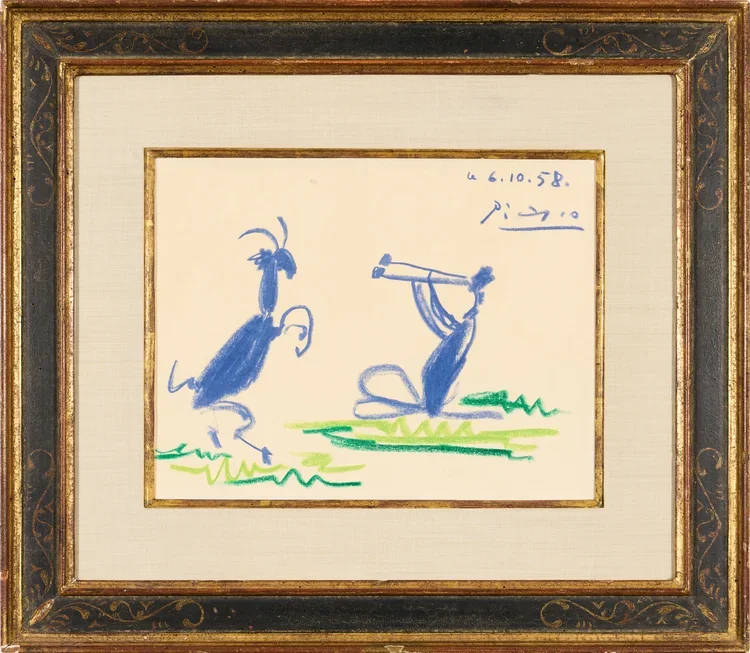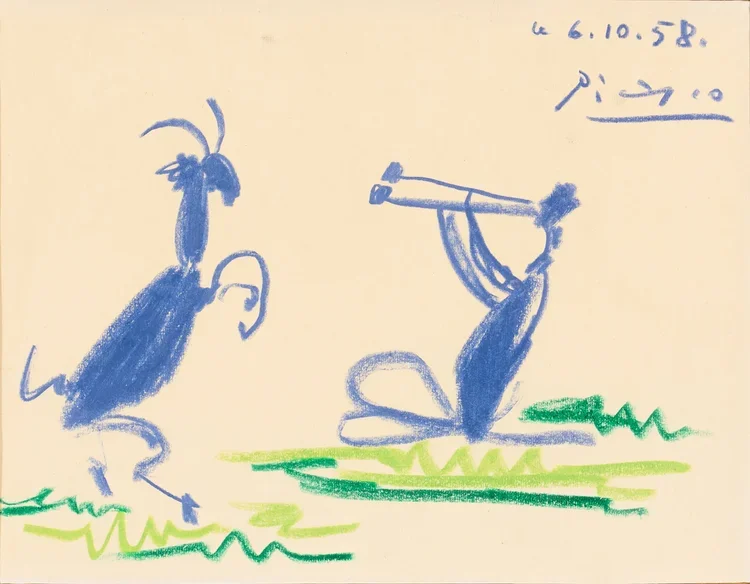Arcadia is pleased to present Pablo Picasso’s “Pan et Faune,” an oil pastel drawing completed in 1958 during one of Picasso’s most productive and versatile periods. This piece is being presented for the first time in over 50 years as it has remained in the same private collection, and comes with a certificate of authenticity from Galerie Urban dated 1971. The piece depicts a seated double-flute player (Pan), facing a faun dancing on its hind legs, a motif Picasso frequently returned to throughout his career.
In the 1920s and 1930s, Picasso was heavily influenced by the growing popularity of classical antiquity and Neoclassicism, whose order and serenity served as a welcome contrast to the horrors of World War I. During the 1920s, Picasso began depicting flute players and mythological scenes in his work while summering in Cap d’Antibes in the south of France. He was inspired by ancient Greek myths and tales of the Greek gods that were believed to roam the Earth and cause mayhem.
These early flute players were inspired by the Ancient Greek deity Pan, god of fields and woodland areas, and fauns, mischievous half-men half-goat creatures that were Pan’s followers. In one myth, a nymph named Syrinx rejects Pan for his goatish appearance and turns herself into a group of marsh reeds to escape the god’s advances. Pan fashions the reeds into a flute, inventing the panpipes, and consoling himself of his rejection by making music. Pan was associated with fertility and sexual prowess, and Picasso identified with this deity and the archetype of the faun, a creature of free spirit and mischief. In his early depictions of the motif, flute players tended to be depicted as playing music for bacchanal scenes and are typically understood to convey the spirit of joy and abundance in the Mediterranean environment of the French Riviera.
In the 1950s, following another period of global chaos, Picasso’s idyllic mythological representations evolved, shifting towards scenes of pastoral bliss and merriment. Despite this, 1958 proved to be an overwhelming period in Picasso’s life; his sister Lola passed away in Barcelona, and in May the Fourth Republic collapsed in France, heralding the return of Charles de Gaulle and the creation of the Fifth Republic. Throughout this period, Picasso sought escape and serenity in fantasy, adding a nuanced quality to a motif that once symbolized the years of playfulness and excitement he had ahead, and now served to bring a sweetness to the trying times of the past.
Picasso’s flute players remain a quiet but ever-present motif in his work throughout his life. Rarely the full subject themselves, nonetheless they emphasize the artist's self-identification with the archetype of the faun: mischievous, joyous, and adoring of the Mediterranean world, and the ways in which the artist responded to periods of conflict and chaos.
This piece is available to explore on our website or on our artnet page. Private in-person viewings can be arranged by appointment. For inquiries, additional materials, or to schedule a private viewing, please contact marie@arcadiaappriasals.com.




